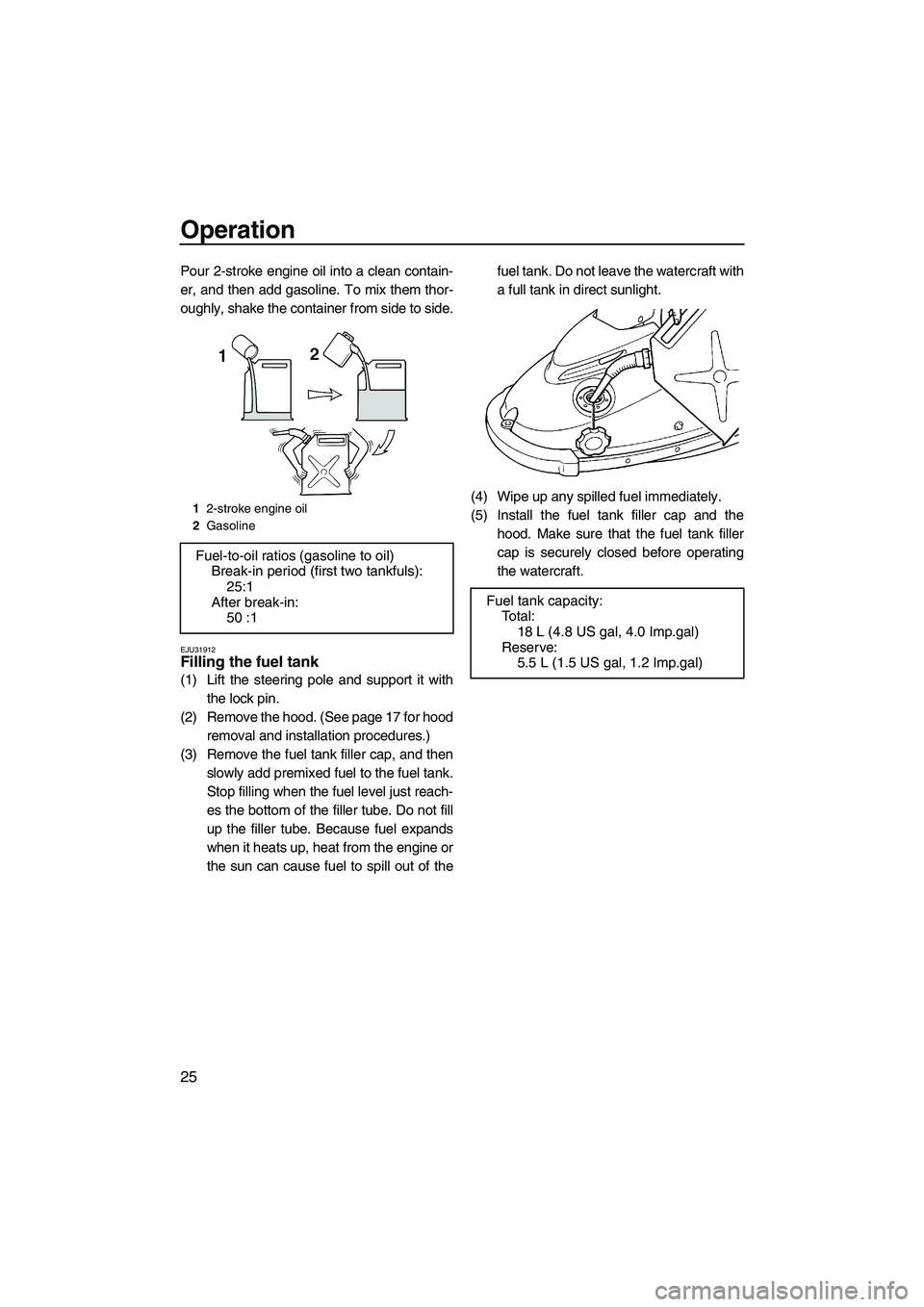Page 32 of 76

Operation
25
Pour 2-stroke engine oil into a clean contain-
er, and then add gasoline. To mix them thor-
oughly, shake the container from side to side.
EJU31912Filling the fuel tank
(1) Lift the steering pole and support it with
the lock pin.
(2) Remove the hood. (See page 17 for hood
removal and installation procedures.)
(3) Remove the fuel tank filler cap, and then
slowly add premixed fuel to the fuel tank.
Stop filling when the fuel level just reach-
es the bottom of the filler tube. Do not fill
up the filler tube. Because fuel expands
when it heats up, heat from the engine or
the sun can cause fuel to spill out of thefuel tank. Do not leave the watercraft with
a full tank in direct sunlight.
(4) Wipe up any spilled fuel immediately.
(5) Install the fuel tank filler cap and the
hood. Make sure that the fuel tank filler
cap is securely closed before operating
the watercraft.
12-stroke engine oil
2Gasoline
Fuel-to-oil ratios (gasoline to oil)
Break-in period (first two tankfuls):
25:1
After break-in:
50 :1
Fuel tank capacity:
To t a l :
18 L (4.8 US gal, 4.0 Imp.gal)
Reserve:
5.5 L (1.5 US gal, 1.2 Imp.gal)
UF2F71E0.book Page 25 Thursday, April 10, 2008 11:47 AM
Page 34 of 76

Operation
27
EJU32280Pre-operation check points EJU32291Engine compartment
WARNING
EWJ00460
Failure to ventilate the engine compart-
ment could result in a fire or explosion. Do
not start the engine if there is a fuel leak or
a loose electrical connection.
Ventilate the engine compartment before
each use.
To ventilate the engine compartment, lift the
steering pole and support it with the lock pin,
and then remove the hood. (See page 17 for
hood removal and installation procedures.)
Leave the engine compartment open for a few
minutes to allow any fuel vapors to escape.
While the engine compartment is open, check
for loose electrical connections.
EJU32350Hull and deck
Check the hull and deck for cracks and other
damage. If any damage is found, have a
Yamaha dealer repair the watercraft.
EJU32361Fuel system
Make sure that there is sufficient fuel in the
fuel tank before each use.
Also, check the fuel system for leakage,
cracks, and malfunctions. (See page 51 for
check points and correct procedures.)(1) Remove the fuel tank filler cap to release
any pressure that might have built up in
the fuel tank.
(2) Remove the hood. (See page 17 for hood
removal and installation procedures.)
(3) Check the fuel level in the fuel tank and
replenish if necessary. (See page 25 for
filling procedures.)
(4) Install the fuel tank filler cap and the
hood.
EJU32420Water separator
Check the water separator for water. The wa-
ter separator retains any water that may have
entered through the fuel tank breather hose if
the watercraft was capsized. Normally, the
water separator is empty.
If water remains in the water separator, drain
it by removing the drain screw. Place a drain
pan under the water separator to catch the
1Water separator
2Drain screw
UF2F71E0.book Page 27 Thursday, April 10, 2008 11:47 AM
Page 52 of 76

Maintenance and care
45
EJU33480
Storage
WARNING
EWJ00320
Always turn the fuel cock knob to “OFF”
when storing the watercraft, otherwise
fuel could leak out into the engine or en-
gine compartment, which would create a
fire hazard.
Storage for long periods of time, such as win-
ter storage, requires preventive maintenance
to ensure against deterioration. It is advisable
to have the watercraft serviced by a Yamaha
dealer prior to storage. However, the following
procedures can be performed by the owner.
EJU33513Flushing the cooling system
Flushing the cooling system is essential to
prevent it from clogging with salt, sand, or dirt.
(1) Place the watercraft in a horizontal posi-
tion.
(2) Remove the hood. (See page 17 for hood
removal and installation procedures.)
(3) Remove the flushing hose connector
cap, and then insert the garden hoseadapter into the flushing hose connector
and turn it until it is securely connected.
(4) Connect the garden hose adapter to a
water tap using a garden hose.
TIP:
A garden hose is not included.
(5) Start the engine, and then immediately
turn the water supply on until water flows
out continually from the cooling water pi-
lot outlet. NOTICE: Do not run the en-
gine for more than 15 seconds without
supplying water, otherwise the engine
could overheat.
[ECJ01010]
TIP:
If you will be storing the watercraft for a pro-
longed period, such as winter storage, top off
the fuel tank with fresh gasoline and add fuel
stabilizer and conditioner to the fuel tank ac-
cording to the manufacturer’s instruction be-
fore starting the engine.
(6) Run the engine at idling speed for about
3 minutes watching the engine condition.
If the engine stops while flushing, turn the
water supply off immediately and repeat
the above steps. NOTICE: Do not sup-
ply water to the cooling water passag-
es when the engine is not running. The
water could flow back through the
1Garden hose adapter
2Flushing hose connector
3Flushing hose connector cap
UF2F71E0.book Page 45 Thursday, April 10, 2008 11:47 AM